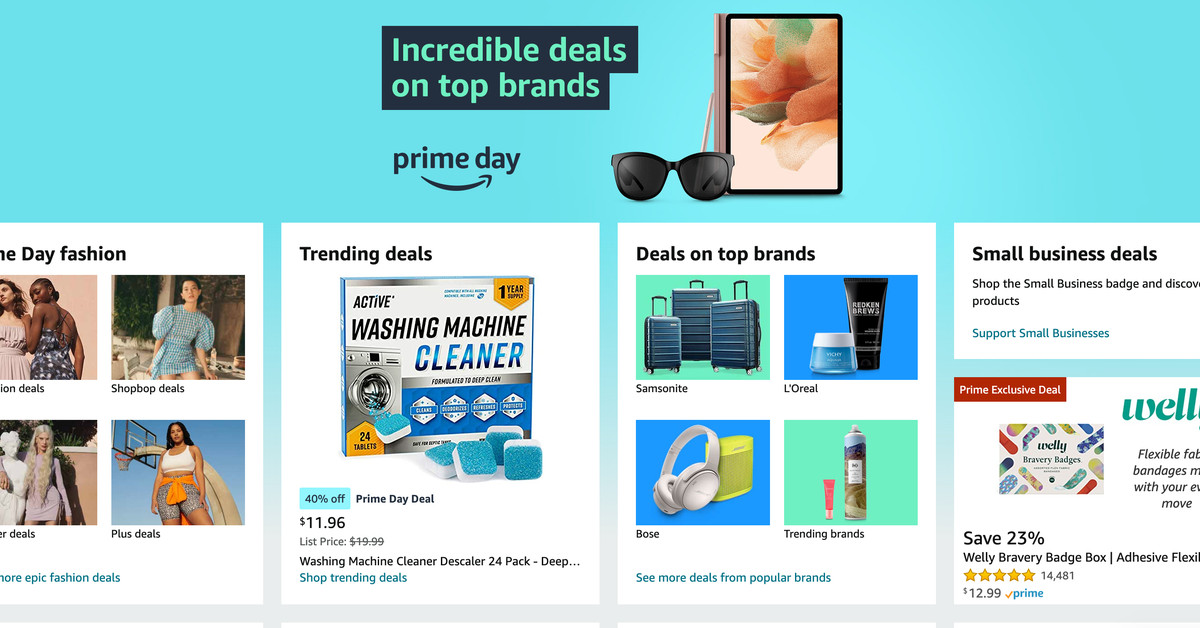Everybody loves a good deal. That’s largely the appeal behind e-commerce “holidays” like Amazon Prime Day. The only problem is while you’re lured in by the promise of paying less, you might actually find yourself bamboozled.
In recent years, Amazon’s become a minefield of legitimate products mixed with counterfeits. It’s not just charlatans peddling snake oil, either. (Though, there’s plenty of that, too.) The problem has gotten so bad that Amazon’s own products have been hijacked by counterfeiters, and in 2020, the company launched a Counterfeit Crimes Unit to combat the sheer number of knockoffs on its site. In 2021, Amazon claimed it had blocked over 10 billion phony listings.
And that’s just the fake products. A 2019 Wall Street Journal investigation found that Amazon sold thousands of banned, mislabeled, or unsafe products too. CNBC also found Amazon shipped expired groceries, including expired baby formula.
Those shady products can be hard to spot on a regular day. Amazon Prime Day is a two-day bonanza where thousands of items are discounted. Even if Amazon had vetted each item as the real thing, some retailers aren’t above duping consumers into thinking they’re getting a better deal than they actually are. Many will artificially bump up prices before events like Amazon Prime Day to make the day-of deals more attractive. (You can use sites like CamelCamelCamel to double-check an item’s pricing history before you add it to your cart.)
In the case of tech companies, many will use it as an opportunity to clean out excess inventory. Sometimes that can be a good thing, provided you’re well-informed and don’t mind a last-gen device. Other times, you’re getting a “discount” on an item that may soon be obsolete and will have to be replaced sooner than you expect.
This is true every year. But while the Verge Deals team is diligently sifting through the noise to bring you the best deals in every fathomable category, I’m not here to do that. I’m here to show you some examples of what I described above, aka why Prime Day is the worst. (But really, Amazon Prime Day is simply the worst because I had to watch this commercial.)
Apple 5W USB Power Adaptor
:no_upscale()/cdn.vox-cdn.com/uploads/chorus_asset/file/23764628/Screen_Shot_2022_07_13_at_1.24.40_PM.png)
Apple charges an ungodly $19 for this stupid white brick that it used to include with its products for free. Not only do you probably already have one (or two, or three), but in 2022, there are several other options that get you a better bang for your buck. These days, 5W adaptors can be slow charging certain devices — and may not cut it if you’re looking for fast charging on a newer gadget. Plus, an increasing number of devices require more juice to charge at a normal rate. (The Sonos Roam, for example, requires a 10W adaptor at least.) Apple itself sells a 12W version of this for $19 as well. So while $12 may seem cheap, it’s probably on sale because it’s an increasingly obsolete device that won’t get you as much mileage over time, especially since this charger still uses USB-A and more companies, including Apple, are shifting toward USB-C.
It also doesn’t help that several reviews for this listing claim to have received counterfeit devices that didn’t work.
10-inch Meta Portal Display
Facebook/Meta Portal devices are being sold for $35 on Amazon.
(Meta is giving up on this product for consumers. I assume this is an inventory clear out?) pic.twitter.com/aq2DxjtIcX
— Shira Ovide (@ShiraOvide) July 12, 2022
While this deal is no longer active, the tweet pretty much says it all. An 80 percent discount seems too good to be true, and in this case, it is. Earlier in June, we reported that Meta was planning to stop making the Portal for consumers. This is an instance where it’s clear that a company is making a cash grab while it can.
This device is unlikely to receive much love going forward. One customer in the reviews shares that some features like Netflix and Hulu no longer work as of April 2022. It’s OK if you knew this going in, but not everyone who bought it probably does. It’d have been better if Meta disclosed this on the listing itself. (It didn’t.)
Dr. Death DVD
:no_upscale()/cdn.vox-cdn.com/uploads/chorus_asset/file/23764791/Screen_Shot_2022_07_12_at_1.45.45_PM.png)
This is not about the quality of Dr. Death. This is about how the DVD is more expensive than the Blu-ray — which is the opposite of how it usually goes, given that DVD sales have plummeted 86 percent between 2008 and 2019. Chances are you have a streaming service already or can sign up for a free trial to watch this series. (In some regions, this is actually available to rent on Prime Video for $2.99 and to buy for $9.99.) Either way, there are several cheaper ways to watch this show. Even if you prefer physical media, this is one category where it pays to do some comparison shopping.
:no_upscale()/cdn.vox-cdn.com/uploads/chorus_asset/file/23764893/Screen_Shot_2022_07_12_at_2.05.14_PM.png)
There are a lot of baffling things here, not least of which is the fact that the seller refers to this as both a Japanese samurai sword and a Chinese Sword. If you look at the listing, you’ll see it’s purportedly discounted by $22.80 from an original price of $114. But if you look up the item’s pricing history on CamelCamelCamel, it’s a different story.
:no_upscale()/cdn.vox-cdn.com/uploads/chorus_asset/file/23764913/Screen_Shot_2022_07_13_at_2.35.16_PM.png)
This item has only been priced at $114 since May 5th this year. Prior to that, it was priced consistently at $109. A generous reading would be the bump is a result of inflation, except if you plug a sword priced at $109 in 2021 (and early 2022) into an inflation calculator, it’d need to cost $119.19 to make up the difference. More telling is that for the majority of this year thus far, this sword also cost $109. That means the recent bump is likely a ploy, and you’re really getting a 16 percent discount. Not 20 percent.
That’s a fairly minor example but take this pound of tumbled rocks.
:no_upscale()/cdn.vox-cdn.com/uploads/chorus_asset/file/23764954/Screen_Shot_2022_07_13_at_3.07.38_PM.png)
If you went off this listing alone, you’d assume that you’re getting: 1) the lowest price on this item in 30 days and 2) a 51 percent discount from a retail list price of $40.99. But let’s look at the 3-month pricing history of this product listing from Camelcamelcamel.
:no_upscale()/cdn.vox-cdn.com/uploads/chorus_asset/file/23764947/Screen_Shot_2022_07_13_at_2.36.35_PM.png)
As you can see, this product doesn’t retail for $40.99. It retails for somewhere between $23 and $25. You’re actually getting a $3-$5 discount.
There are literally thousands of Prime Day listings — some of which are lightning deals that require you to make decisions quickly. It’s impossible for anyone to comb through them all diligently. That said, these are only a few examples I found in roughly 30 minutes altogether. I have no doubt that there are thousands more just like these from trusted and shady retailers alike.
No one is saying that you can’t partake in sales. Some of us depend on discounted items to buy essentials or make ends meet. But again, these e-commerce sites and retailers don’t always play fair. You don’t deserve to be duped, so it pays to shop smart and have a healthy dose of skepticism when perusing the internet’s worst garage sale. If a discount seems too good to be true, it probably is.



